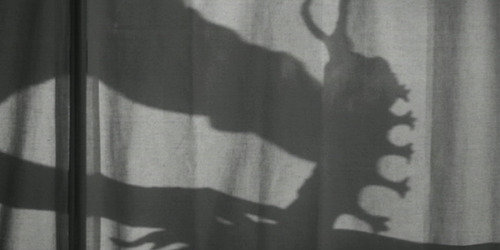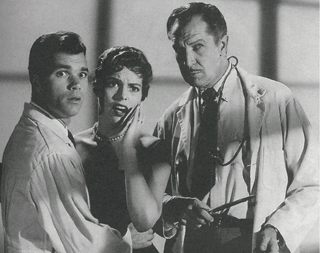

William Castle had been making movies since 1943, not necessarily the kind of movie you'd still remember the next year, but nicely made movies.
In 1958, however, he decided to make movies more interesting by adding gimmicks. People who went to see Castle's Macabre were asked to fill in a form that would give $1,000 to their loved ones in case they would go and see Macabre and would die of fright.
Add to this, the movie's tagline ("Keep saying to yourself: it's only a movie... only a movie... only a movie" - a tagline that Wes Craven would borrow a couple of decades later) and you'll know why Macabre gave Castle's career a boost.
Tonight we focus on two of Castle's movies, both well equipped with an intriguing gimmick: The Tingler and House on Haunted Hill.
Because it's a shame that Castle is contantly overlooked by movie buffs who want to write their history of the silver screen. If one really tried to innovate cinema by making it more interactive, we shouldn't look down upon this director as a creator of gimmicks.
Tonight we give Castle the spotlight he craved for and frankly really deserved...
 Here's a reason never to have kids: Castle's kids recently gave Hollywood the chance to remake some of his movies. But without the creative mind of Castle these remakes were even much worse than the remade fodder we're normally subjected to. While "Thirt13n Ghosts" still had the merits of adding glass walls it didn't come close to Castle's original (13 Ghosts) and the way they wrote the title didn't help much either.
House on Haunted Hill (1999) didn't even change the title, it just took out everything that was fun about the original Castle movie.
Here's a reason never to have kids: Castle's kids recently gave Hollywood the chance to remake some of his movies. But without the creative mind of Castle these remakes were even much worse than the remade fodder we're normally subjected to. While "Thirt13n Ghosts" still had the merits of adding glass walls it didn't come close to Castle's original (13 Ghosts) and the way they wrote the title didn't help much either.
House on Haunted Hill (1999) didn't even change the title, it just took out everything that was fun about the original Castle movie.
And yes, House on Haunted Hill (1959) was lots of fun. Vincent Price stars as a millionaire who invites a group of people to spend a night in his house. If they survive the night they'll get $10,000. And that's when we get a display of blood dripping from the ceiling, moving skeletons... all the things you'd expect from a spook show.
Is it a scary horror film? No. As Sean Axmaker put it, "William Castle's gimmick-laden comic thriller is not so much a horror movie as a fairground funhouse come to life."
Even Emergo, the gimmick invented for this movie, is an example of the funhouse fun Castle tried to put into this movie: at the time when the skeleton moved towards the screen, Castle made sure an actual skeleton (that was hidden behind a curtain next to the screen) would come flying towards the audience.
House on Haunted Hill was an improvement on Macabre, both as a movie (the script and performances are better) and as far as the gimmick was concerned.
However, this wasn't the last time Castle would try and invent gimmicks to give his movies just that little bit extra.

 This is probably the best-known of Castle's movies. Could that be because of Vincent Price playing the lead (again)? Could it be because this is a black and white movie with one colour scene (the bloody delirium)? Or because William Castle outdid himself with the gimmick? Probably it's all of these factors combined.
This is probably the best-known of Castle's movies. Could that be because of Vincent Price playing the lead (again)? Could it be because this is a black and white movie with one colour scene (the bloody delirium)? Or because William Castle outdid himself with the gimmick? Probably it's all of these factors combined.
A tingler is a little creature that grows inside you when you're afraid and you don't scream. If you scream the tingler stops growing. But if you don't shout the tingler keeps growing until you... die! That's why you better scream for your life when you're afraid.
The thing is, how do you know that there's a tingler inside you? Well, when you're afraid you'll feel it grow, as if there's an electrical impulse going through your body.
And yes, people, you've just guessed Castle's gimmick: he had made sure there were some wired seats in the audience. Somewhere during the movie there's a scene where the movie pretends to stop: the screen goes black and you only hear the voice of Vincent Price, informing you that the tingler has escaped and it's loose. If you feel the tingler, shout... shout! Shout for your life!
At which point you'd feel a buzz and probably started shouting.
The Tingler has a decent script and good performances, which is why this is so much more than a gimmick movie.
As briefly mentioned earlier, there is a scene where blood is running from a tap and because it was too expensive to shoot the movie in colour and because this scene wouldn't be so effective in B&W this scene is shot in colour.
It actually works and gives the scene a touch of delirium, much like in these days flashbacks are occasionally shot in black and white to appear like 'older' footage.
If you look at the full package (script + performances + gimmick) it's hard to find a better Castle movie than The Tingler. Then again, if you see that a full package needed to make a good movie The Tingler may just be the best movie in the world.

William Castle also invented gimmicks for some of his other movies. For the movie 13 Ghosts you needed 3D glasses to see the ghosts, while Mr. Sardonicus was an early experiment of interactive viewing: the audience got to decide the fate of the bad guy at the end. They could hold up a green or a red card to vote whether the evil character would live or die. Apparently the audience always voted for the bad ending, sparking a discussion as to whether Castle had actually made a second ending. Allegedly it was made, but it seems nearly impossible to track down.
We save the best for last: Homicidal's gimmick was the Coward's Corner. If you were too scared to watch the end of the movie you would get your money back at the Coward's Corner.
The drawback: the Coward's Corner was just outside of the screening room and you'd have to wait until the end of the movie before you'd get your money returned. Leave it to Castle to add the touch of a spotlight shining in your face, just so everybody that watched the movie until the end would leave the studio and see you clearly as the coward you really are.
Castle didn't really like the idea of people leaving during the movie, so just before we get to the climax of the movie we would hear a heartbeat warning us the climactic ending was near. A clock would appear on the screen (pictured above) and a voiceover would inform us that if you were too scared to watch the end of the movie this would be the moment to leave the studio. Castle called this the "Fright Break".
Castle's creativity in movies is only matched in the autobiography he wrote, Step Right Up. You'd be daft to believe every single word, but it's an incredibly entertaining read. It's a shame the book isn't published anymore, but you might be lucky and find it somewhere. It's definitely something to look out for.
Written by Kurtodrome. Images courtesy of own collection or House of Horrors
The Kurtodrome Vault is part of the Kurtodrome.